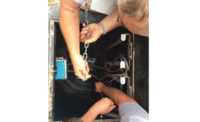Waterborne diseases were, at one time, the largest health threat to human life. In the 19th century, it was not uncommon to contract typhoid or cholera in the morning and be dead by evening. Chicago treated the Chicago River as its dumping grounds for all manner of waste, including human and animal waste from slaughter houses located along its banks. In August 1834, the steamboat Chicago arrived in port with its captain reporting two of its crew had died from cholera. The Chicago townsfolk demanded action, as the city had gone four days without an incident of cholera. Fears of a cholera epidemic resulted in the creation of the Chicago Board of Health (CBoH) in 1835.
Although the CBoH made great strides in staving off cholera — and other diseases — there continued to be outbreaks. In 1854, 1,424 deaths were attributed to cholera, while another 242 died from dysentery along with 210 more from diarrhea (both of which may well have been cholera). On average, for every 100,000 people, 65 Chicagoans would die from typhoid every year. Stephen A. Douglas who ran for president in 1860, succumbed to typhoid fever on June 3, 1861 in Chicago. The connection between good sanitation and waterborne diseases were now understood to be closely tied together. Potable water is drawn from Lake Michigan: The citizens of Chicago were drinking their own toilet water.
Thanks to the Erie Canal, which opened in 1825, commerce connections were established between the Hudson River to Buffalo, New York, and thereby connected the east to the Great Lakes and away from New Orleans and St Louis. (More on St. Louis and an attempted injunction against Chicago below). In 1833, 20,000 people would arrive in Chicago by boat! An Illinois and Michigan Canal between the Chicago and Des Plaines rivers, following an established portage route, resulted in Chicago becoming part of Illinois rather than Wisconsin when the border was extended 50 miles north to maintain any future canal within Illinois borders.
In 1856, engineer Ellis Sylvester Chesbrough designed the first sanitary sewer system in the U.S. for Chicago. There was a problem, however, with the plan for the gravity-flow sewer system: Not enough natural grade for drainage (fall), so they did what creative folks do — they raised the streets! With streets now at the second floor level for buildings, folks either raised their buildings or turned their first floors into basements. The new sanitary sewer system exacerbated the issues by increasing the amount of raw sewage into the Chicago River, and pollution plumes, which included sewage, occasionally enveloped the potable water intakes leading to more outbreaks of waterborne disease. In 1867, Chicago moved its Chesbrough-designed potable water intake crib and tunnel two miles offshore — well beyond the pollution plume.
Dilution is the solution to pollution
In 1881, Chicago hired Rudolph Hering, who was deemed an expert on sewage, to determine a safe means of sewage disposal for the city. Hering began his engineering studies at age 13 at Technische Universität Dresden in Germany. Hering said to forget the ineffectual Illinois and Michigan Canal (I&MC) and construct a new, much wider and deeper canal to offer dilution of the Chicago River’s sewage by introducing copious amounts of Lake Michigan water to be mixed with the pollution. When the governing board of the I&MC demanded they would be in charge of an expanded I&MC while charging fees for passage, the Sanitary District of Chicago (SDC) balked. In 1892, the SDC authorized construction of the Sanitary and Ship Canal, which is to reverse the flow of the Chicago River while, at the same time, provide a means for transportation of goods to the Des Plains River and onward to the mighty Mississippi River and the Gulf. The game is afoot!
A diversion channel was constructed for the Des Plaines River along with its 19-mile long levee to enable construction on Aug. 24, 1892. Groundbreaking for the Sanitary and Ship Canal (SSC) was Sept. 3, 1892. After several chief engineers came and went, the fifth and final chief engineer, Isham Randolph was hired on June 7, 1893. One thing I discovered while researching this amazing feat of engineering was that Randolph was not actually an engineer by way of formal training. His family owned slaves and he first learned engineering from one of their slaves. Randolph worked for the Baltimore and Ohio Railroad as axeman, and later served as assistant engineer for the Scioto Valley Railroad. Randolph oversaw the construction of the SSC, and would later move on to the construction of the Panama Canal.
The Des Plaines River meets up with Kankakee to form the Illinois River and that is just upstream from St Louis. St Louis started worrying about the SSC pollution in 1898, but politics (sausage and laws!) moves at a snail’s pace and it wasn’t until a year later they thought: Wait a second, we’re going to be drinking Chicago’s sewage! Off to the United States Supreme Court with a petition to call a screeching halt to the SDC and state of Illinois construction of the SSC. Loose lips sink ships and so do leaks — word got back to Chicago well before St Louis was ready to file their petition with the SCOTUS. The dilemma for Chicago and opening the SSC was that it needed to be complete and working before the Illinois Governor could grant operational status.
SDC officials decided to move with haste while not publicly announcing an opening date out of fear that would prompt St Louis officials to hasten their petition before the SCOTUS. So it was that on a frigid windy early morning on Jan. 2 without fanfare, SDC officials gathered with hastily obtained shovels in a valiant attempt to dig open the dam blocking flow from the Chicago River to the SSC. Lacking sufficient progress, Big Dredge No. 7 was activated to carve out a break in the dam. However, the dredge was unable to reach far enough to completely breach the dam, so an attempt was made to use dynamite, which was an utter failure. With great effort, the dredge was relocated and began tearing into the remainder of the dam. Success! Water from the Chicago River cascaded into the newly formed SSC.
One hitch remained: Lowering the Bear Trap Dam at Lockport, which would allow water from the SSC to pour into the Des Plaines River. Permission to lower the dam required approval from a three-man commission and the governor. It was January 17, 1900, and this was the same day the St Louis and Missouri injunction request was to be heard before SCOTUS. Permissions were obtained, and the Bear Trap Dam lowered at 11 a.m. at the Lockport Controlling Works.
Having missed their window of opportunity, St Louis ended up building water treatment plants to protect its citizens. In 1908, Chicago became the second city in the U.S. to chlorinate its drinking water. In 1914, the SDC built the first sewage treatment plant. Waterborne diseases in Chicago and in the U.S. begin to become virtually non-existent. Engineers and plumbing contractors together bring plumbing indoors and create modern sanitary plumbing systems that have saved more lives than all of the advances in medicine throughout all time.




